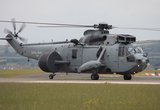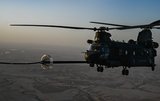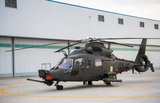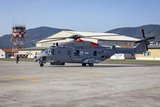Royal Navy personnel lead the way in Arctic survival
The elite Arctic Training cell from the Commando Helicopter Force departed their home base at Royal Naval Air Station Yeovilton in November 2010, for the extreme conditions of Northern Norway to exercise their Arctic Warfare skills.
Based at Royal Norwegian Air Force Bardufoss, 200 Miles inside the Arctic Circle where the sun barely struggles above the horizon, their task was to train both aircrew and engineers from 845 and 846 Naval Air Squadrons in the freezing temperatures and snow to ensure they could operate in the most demanding and hazardous weather environment.
It was a perilous route for the intrepid aviators of the Sea King helicopter Squadrons. After leaving the comfort of Somerset they had to transit up to RAF Leuchars in Scotland and then on to an oil rig in the middle of the North Sea to pick up fuel before reaching their initial destination in Southern Norway. At some point there would be a point of no return whereby the aircraft and aircrew would have to “sink or swim” should the aircraft suffer a catastrophic problem – no pressure!! From there, it was a flight North, all the way up the coast of Norway to Bardufoss.
Despite the manning pressures exerted by current commitments in Afghanistan, personnel from CHF regularly deploy to Bardufoss and have done so since 1969. The deployment is known as “Clockwork” to military and locals alike. This year a large contingent of Army and RAF personnel attended the gruelling course.
The first phase of the deployment is the Cold Weather Survival Course, run by Royal Marine Mountain Leaders. Personnel have to learn how to live, work and survive in the harsh field conditions of the Arctic. The first 3 nights of the course are spent living under canvas with the luxury of a cosy arctic sleeping bag. However, having been lulled into a false sense of security they are then placed into a survival situation on the final night, with only the clothes they are wearing.
For many of those deployed this will be the first time they have found themselves in the Arctic Circle without a roof over their heads is a challenging and intense experience! For everyone completing the course, it is an admirable achievement, and for many it is one of the hardest things they have ever done. In fact during the survival phase, the wind-chill effect caused the temperature to plunge to minus 45°C, far beyond the typical temperature of a mere minus 26°C!
Lieutenant Commander ‘Spidey’ Clarke, Officer Commanding Clockwork, now on his seventh deployment to the Arctic Circle said:
“The Arctic environment is particularly harsh and provides the opportunity for individuals to test themselves in extreme temperatures and under the most arduous conditions."
"However the most painful part of the course is the swim, with full kit, in the Bardufoss swimming pool, which is carved in the ice of a lake."
"It certainly is quite testing but the tot of rum issued at the end of the swim certainly aids recovery”
In addition to simply surviving, CHF aircrew from 845 and 846 Naval Air Squadrons must be able to fly in these incredibly inhospitable conditions utilising a variety of flying techniques, including landing on top of mountains, in order to support their primary customer, the Royal Marines Commando Units. But it is not just the aircrew in danger. Cold metal at such low temperatures will act like superglue and aircraft maintenance becomes a gruelling test of character.
The Engineers are also ready at a moment’s notice to retrieve the Sea King if the Aircrew have to make an emergency landing, which they call a ‘down-bird’. If the down-bird is in a remote area, the aircrew can quickly be in a real survival situation. Ten minutes flying can equate to ten hours of hard yomping through deep snow.
Many squadron members particularly miss their loved ones during the long dark nights whilst in Norway. The facilities for getting in touch with family have improved greatly over the last few years, with the addition of a number of Internet terminals on the camp. Enjoying northern Norway’s breathtaking scenery with its mountains, fjords, glaciers and even stray Elk wandering across icy roads can offset the time away from home. In their spare time, personnel can enjoy winter activities such as skiing, snow boarding and dog sledding with Huskies.
For 845 and 846 NAS, the deployment ends with some more Arctic camping, but this time operating the aircraft in a tactical environment. The newly trained personnel even defend their Operating Base from the attacking Norwegian troops, day and night.
The much-anticipated journey back to RNAS Yeovilton takes place in late March and will take the Sea King helicopters four days with overnight stops in Central and Southern Norway and Scotland; another winter deployment complete …. until next year! The Junglie ethos of “train hard fight easy” has been achieved.
Source: Fleet Air Arm
More from Defence Helicopter
-
![Germany to send WS-61 Westland Sea King helicopters to Ukraine]()
Germany to send WS-61 Westland Sea King helicopters to Ukraine
Germany has committed to sending Ukraine six of its 21 retiring WS-61 Westland Sea King multirole, amphibious helicopters.
-
![Boeing secures $271 million to advance modernisation of US Special Operations' MH-47G Chinook]()
Boeing secures $271 million to advance modernisation of US Special Operations' MH-47G Chinook
Boeing has clinched a major contract modification to further its backing of the US Special Operations Command’s MH-47G Chinook aircraft modernisation effort.
-
![Dubai Airshow 2023: South Korean homegrown helicopters make international debut]()
Dubai Airshow 2023: South Korean homegrown helicopters make international debut
Two KAI helicopters, the KUH-1E utility helicopter and the Light Attack Helicopter (LAH), have taken centre stage at the Dubai Airshow 2023.
-
![Italian Navy receives final NH90 helicopter]()
Italian Navy receives final NH90 helicopter
The Italian Navy now boasts a fleet of 56 NH90 helicopters comprising 46 SH-90As and 10 MH-90As.
-
![Argentina seeks AW109 and CH-46 Sea Knight helicopters]()
Argentina seeks AW109 and CH-46 Sea Knight helicopters
The Argentinian Air Force (FAA) and the Argentinian Naval Aviation Command (COAN) are looking for options to upgrade their helicopter fleets.
-
![DSEI 2023: Lockheed to produce about 40% of Black Hawks on UK soil if it wins NMH contest]()
DSEI 2023: Lockheed to produce about 40% of Black Hawks on UK soil if it wins NMH contest
Lockheed Martin promises a boost to the British job market and export opportunities, while strengthening ties with Poland and positioning the UK for a future in rotorcraft technology in the event of a New Medium Helicopter competition triumph.

























